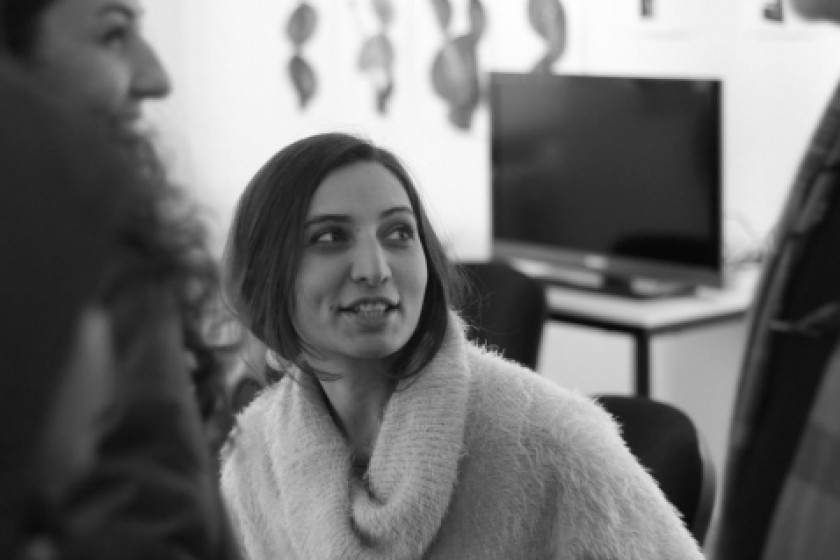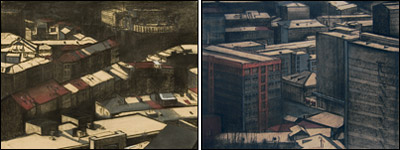
Artist Mary Moon: Yerevan’s Urban Upheaval Portrayed on Canvas
Her paintings are void of people; The city has swallowed its residents
“Everyone knows, especially politicians and government officials, that artists are capable of changing everything. That’s what is dangerous. That’s why they often exert pressure on artists. It’s happened before and continues today," says Mary Moon, the artist formerly known as Arakelyan. "And it won’t change, because artists have always thought about what takes place around them more than others,” she continues.
Even though May firmly believes that artists can have an impact on the political decision-making process, she herself identifies with no political movement. The artist believes that there are those who merely mouth words that they like and dislike. Artists do the same with the work they create. The medium employed by artists to speak is a grace they are born with – music, fine arts, or others. In Mary’s case the medium is painting.
Politics drives how Yerevan looks
Mary paints our city, its hidden and oft frequented spots, buildings old and new, streets and alleys. However, you’ll be hard-pressed to spot an actual city location in her work. Mary says that when she puts brush to canvas, her main aim isn’t to create a city map but to let concepts flow freely; to come up with an impression of the city
. 
A cursory glance at her paintings leaves one with the impression that the artists focuses mainly on scenes of urban construction. But scratch the surface and you’ll again find politics at the core. In the end, its politics that drives the manner in which a city is built and appears. Nevertheless, the artist says that her work isn’t political in the narrow sense of the word. It’s urban painting, a result of treks and meanderings through an urban landscape. “I would go to paint sketches and the vision immediately came to me. I saw the city from on high at the Cascade promontory - one sketch, then two, three. It became a complete series. I started to paint other cities. I sort of froze the city in my mind and documented its essence, internally. I did away with the external trappings and natural appearance. This is what I use as my base,” Mary says. It would appear that Mary has hit upon the best way to express herself. Colors are muted and she unusually uses pastels. As to technique, she prefers printing since its most effective at presenting an urban panorama, while also leaving the effect of photography.
The artist focuses on city’s constant change
Themes for Mary’s paintings are particularly found in the constant changes taking place in the city. “At first, I wasn’t sure if all the construction going on was affecting me in some way. Like everything else, you only understand what is affecting you later on. That’s what happened with me and the surrounding construction.”

Painting requires refinement of thought
Mary says that the first step in the painting process is to wait for an idea or concept to come. It must then be refined and transformed into a story. Only then can you retell it on the canvas.
“First off, they are emotions that gradually crystallize into an idea. How does that idea come forth? It is beaten and kneaded until something else is born. And what comes out can’t be bad after all that perfecting and polishing. The end result is something that has been cleansed, refined and more accessible. It’s that pure thought that must be conveyed to the viewer, stripped of excess baggage” Mary explains. When Mary first started to paint sketches of the city, her friends said that they couldn’t recognize Yerevan in the sketches. “No one recognized the city from above. People couldn’t even identify the city where they live. It was because they gazed over the town from high above. Also, the city has changed quite a bit.” When I asked Mary what she thought about the new buildings going up and new neighborhoods being carved out, she said that the town was in a constant state of flux.
“Every day you go to school, to work, or for an evening stroll, and you eye slowly gets used to it all. After a while, you no longer notice the changes. People see all the demolition but no one knows what will be built in its place. I just paint what was there and what is new. My paintings cry out – ‘Look here, do you like what you see’? I mean, just take a look at Northern Boulevard or some other new high-rise block. It’s all concrete and stone – no green space and no people. This is what I show.” In the cityscapes Mary paints there are no inhabitants. The town is deserted. She says it’s a reflection of the way she feels.
“Humans have been subsumed, taken over, by what they have created. So much so, in fact, that man no longer exists in the world created around him. We no longer exist.”
P.S. – Why the name Mary Moon? The artist points out that she no longer uses traditional last names and “Moon” sounded like a nice moniker.
Mariam Mughdusyan
 Videos
Videos Photos
Photos




Write a comment